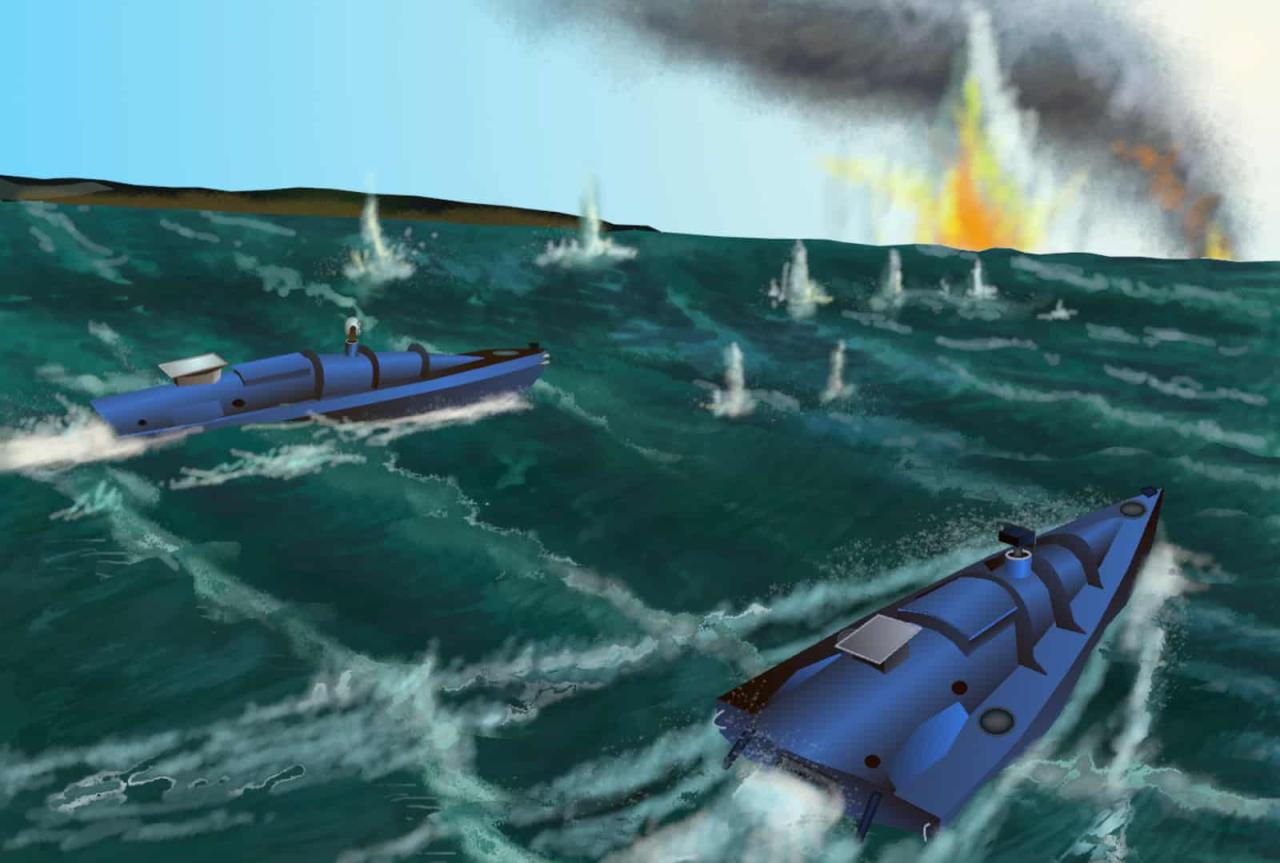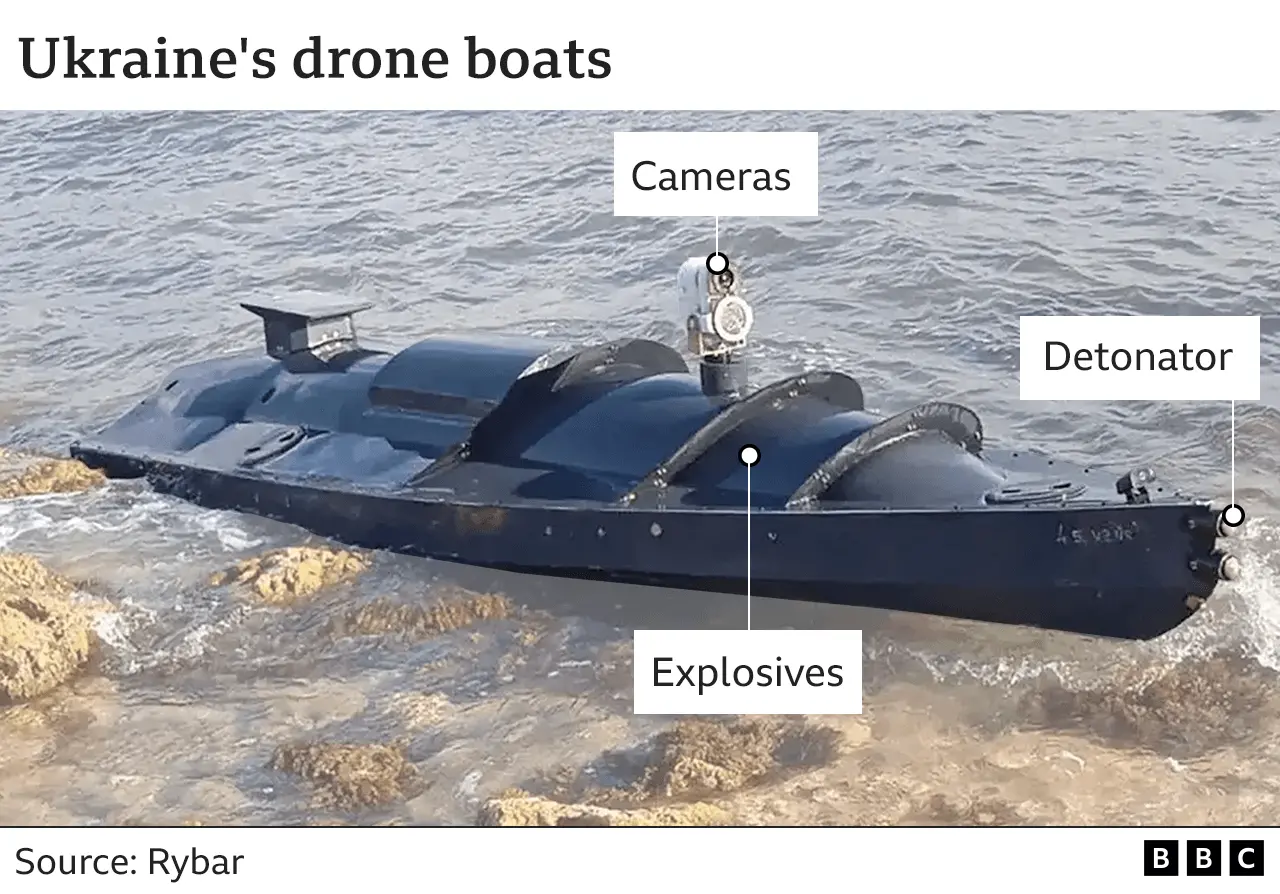Ukrainian sea drones are rapidly changing naval warfare. These unmanned vessels, ranging from small, expendable craft to larger, more sophisticated platforms, offer a potent blend of affordability, adaptability, and surprising lethality. This exploration delves into their design, capabilities, military applications, and future potential, examining their impact on global naval power.
From their innovative propulsion systems to their diverse payloads, Ukrainian sea drones present a compelling case study in modern naval technology. We’ll compare them to similar systems from other nations, analyze their cost-effectiveness, and discuss the ethical considerations surrounding their use in combat. The journey into this fascinating world of maritime robotics promises insights into the evolving landscape of naval strategy and technology.
Ukrainian Sea Drone Technology
Ukraine’s burgeoning sea drone technology represents a significant shift in naval capabilities, particularly in the context of asymmetric warfare. These unmanned vessels offer a cost-effective and adaptable approach to naval operations, challenging traditional power dynamics. Their development has been significantly accelerated by the ongoing conflict, showcasing rapid innovation and adaptation.
Current State of Ukrainian Sea Drone Technology
Ukrainian sea drones are characterized by their modular design, allowing for customization based on mission requirements. They range from smaller, simpler units designed for reconnaissance and surveillance to larger, more sophisticated drones capable of carrying heavier payloads and engaging in offensive operations. The capabilities include autonomous navigation, target acquisition, and data transmission.
Comparison with Other Nations’ Sea Drone Technology
Compared to larger naval powers like the US, Russia, or China, Ukrainian sea drone technology might appear less advanced in terms of sheer scale and technological sophistication. However, Ukrainian designs emphasize adaptability, cost-effectiveness, and ease of production and deployment—crucial factors in a conflict setting. This contrasts with the often larger, more expensive, and complex systems developed by major military powers.
Materials Used in Construction
The construction materials used in Ukrainian sea drones are likely to prioritize affordability and availability. This might include readily sourced materials such as fiberglass reinforced polymers (FRP), aluminum alloys, and readily available plastics. The specific materials used would likely vary depending on the drone’s size, intended mission, and cost constraints.
Propulsion Systems
Ukrainian sea drones likely employ a variety of propulsion systems depending on size and mission profile. Smaller drones may utilize electric motors, offering quieter operation, while larger drones might utilize internal combustion engines or hybrid systems for extended range and speed. The selection of propulsion systems is driven by factors such as payload capacity, operational range, and the need for stealth.
Comparison of Ukrainian Sea Drone Types
| Drone Type | Range (km) | Payload (kg) | Speed (knots) | Stealth Capabilities |
|---|---|---|---|---|
| Type A (Example) | 50 | 50 | 15 | Moderate (Low Radar Cross Section) |
| Type B (Example) | 100 | 100 | 20 | High (Specialized Coating) |
| Type C (Example) | 20 | 10 | 8 | Low |
Military Applications of Ukrainian Sea Drones
The strategic and tactical advantages of sea drones in naval warfare are considerable, particularly for nations with smaller navies. Their low cost and expendable nature allow for swarm tactics, overwhelming defenses through sheer numbers.
Offensive and Defensive Applications
Ukrainian sea drones find potential use in various offensive and defensive roles. Offensively, they could be employed in anti-ship warfare, delivering explosives or acting as decoys. Defensively, they could be used for mine detection and clearance, surveillance, and protecting coastal areas.
Anti-Ship Warfare
In anti-ship warfare scenarios, swarms of smaller, less expensive drones could overwhelm enemy defenses. They could be used to target larger, more expensive vessels, potentially crippling them with concentrated attacks or even sinking them. This tactic is particularly effective against larger, slower targets.
Mine-Clearing Operations
Sea drones could be equipped with sensors and mechanisms to detect and neutralize naval mines, significantly reducing the risk to human divers and traditional mine-sweeping vessels. This application would reduce the cost and risk of clearing minefields.
Hypothetical Coastal Defense Scenario

Imagine a scenario where a coastal area is threatened by an amphibious assault. A network of Ukrainian sea drones, equipped with sensors and weaponry, could detect approaching vessels and launch preemptive strikes. Smaller drones could act as decoys, while larger drones deliver payloads to enemy vessels or shore batteries.
The Impact of Ukrainian Sea Drones on Naval Warfare
The introduction of Ukrainian sea drone technology is poised to significantly alter the balance of naval power, especially for nations with limited resources. The cost-effectiveness and potential for mass deployment are game-changers.
Challenges and Limitations
Challenges include vulnerability to electronic warfare, countermeasures like jamming or anti-drone systems, and the need for robust communication networks. The reliance on autonomous navigation also presents challenges related to unpredictable environmental conditions and potential malfunctions.
Cost-Effectiveness
The cost-effectiveness of sea drones compared to traditional naval vessels is a major advantage. A fleet of sea drones can be deployed at a fraction of the cost of a single warship, significantly increasing the reach and capabilities of smaller navies.
Ethical Implications
The use of autonomous weapons systems, including sea drones, raises ethical concerns regarding accountability and the potential for unintended harm. Establishing clear rules of engagement and ensuring human oversight are critical aspects of responsible deployment.
Countermeasures Against Sea Drone Attacks
- Electronic Warfare (Jamming)
- Anti-drone Weapons Systems
- Improved Sensor Technologies
- Network Security Measures
- Deception and Decoy Systems
Development and Production of Ukrainian Sea Drones
The development and production of Ukrainian sea drones involve a collaborative effort between government agencies, private companies, and research institutions. This process is characterized by rapid iteration and adaptation in response to real-world operational needs.
Key Players and Organizations
While specific details regarding the key players and organizations involved in the Ukrainian sea drone industry are often kept confidential for security reasons, it is understood that a network of private companies and government-funded research institutions contribute to the design, development, and production of these systems.
Role of Technological Innovation
Technological innovation plays a critical role in the advancement of Ukrainian sea drone capabilities. The ongoing conflict has driven rapid improvements in areas such as autonomous navigation, target acquisition, and payload delivery systems. This rapid iteration is crucial in maintaining a technological edge.
Funding Sources
Funding sources for the research and development of Ukrainian sea drone technology likely involve a combination of government funding, private investment, and international aid. The specific breakdown of funding sources is not publicly available.
Timeline of Key Milestones
A precise timeline of key milestones in the development of Ukrainian sea drone technology is difficult to establish due to security concerns. However, it is evident that the pace of development has accelerated dramatically in recent years, driven by the urgency of the ongoing conflict.
Ukrainian sea drones are proving surprisingly effective in naval warfare, showcasing the potential of smaller, less expensive unmanned systems. Think about how this technology might evolve – check out the projected advancements at the china drone show 2029 to see what’s on the horizon for drone tech. This kind of innovation could significantly impact future designs of Ukrainian sea drones and similar naval platforms.
Future of Ukrainian Sea Drone Technology

The future of Ukrainian sea drone technology promises significant advancements in autonomy, intelligence, and capabilities. Integration with AI and machine learning will enhance decision-making and operational efficiency.
Potential Future Developments
Future Ukrainian sea drones are likely to incorporate advanced AI for autonomous navigation and target identification. Improved propulsion systems will extend range and speed, while enhanced materials will improve durability and stealth capabilities. Swarm capabilities will likely be significantly improved, allowing for more coordinated and effective attacks.
AI and Machine Learning Integration
The integration of AI and machine learning will allow for more autonomous operation, reducing the reliance on human operators. This will enable drones to adapt to changing conditions and make more effective decisions in real-time.
Ukrainian sea drones are proving surprisingly effective in the current conflict. Their low cost and adaptability make them a potent asymmetric weapon, a bit like the unexpected twists in the squid game histoire vraie narrative. Thinking about the resourcefulness shown in both situations, it’s clear that innovation and clever tactics can overcome seemingly insurmountable odds, especially when it comes to Ukrainian sea drone technology.
Increased Autonomy and Improved Capabilities, Ukrainian sea drone
Future designs will likely focus on increased autonomy, allowing drones to operate independently for extended periods. Improved sensors and communication systems will enhance situational awareness and target acquisition capabilities. Enhanced payload capacities will allow for a wider range of missions.
Ukrainian sea drones are making waves, showcasing impressive autonomous capabilities. It’s a far cry from the dazzling spectacle of a coordinated drone display, like the one you can check out at the china new year drone show , but both highlight the rapid advancements in drone technology. The precision and coordination needed for a massive drone light show, though aesthetically driven, informs the development of the more tactical applications seen in military drones like those used by Ukraine.
Applications Beyond Military Use
Beyond military applications, Ukrainian sea drone technology has the potential for use in environmental monitoring, scientific research, and infrastructure inspection. The adaptability of these systems makes them suitable for a variety of civilian applications.
Conceptual Design of a Next-Generation Drone
A next-generation Ukrainian sea drone might feature a hybrid propulsion system combining electric motors for quiet operation with a small internal combustion engine for extended range. Advanced materials would provide superior stealth and durability. An integrated AI system would enable autonomous navigation, target identification, and engagement, minimizing the need for human intervention. Modular design would allow for customization to various mission profiles.
Closing Notes

Ukrainian sea drones represent a significant shift in naval capabilities, offering a potent and cost-effective alternative to traditional warships. While challenges remain regarding autonomy, countermeasures, and ethical considerations, their potential for both offensive and defensive operations is undeniable. As technology continues to advance, we can expect to see even more sophisticated and versatile sea drones emerge, reshaping the future of naval warfare and potentially influencing other maritime sectors.
Question Bank: Ukrainian Sea Drone
How are Ukrainian sea drones powered?
Power sources vary depending on the drone’s size and mission, but common options include electric motors, internal combustion engines, and even hybrid systems.
What materials are used in their construction?
Construction materials are chosen for durability and stealth, often including composites like fiberglass and carbon fiber, alongside metals like aluminum for structural strength.
What is the range of a typical Ukrainian sea drone?
Range varies greatly depending on the model and design. Smaller drones may have a range of a few kilometers, while larger ones could reach tens or even hundreds of kilometers.
Are Ukrainian sea drones fully autonomous?
The level of autonomy varies. Some are remotely controlled, while others may have varying degrees of autonomous navigation and target acquisition capabilities.
